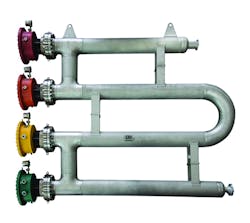A plant operator’s biggest fear is an unplanned shutdown. The process can place a heavy amount of stress on both operations and maintenance personnel. Alternatively, taking full advantage of a planned shutdown or turnaround is critical. Many of the maintenance activities that need to be conducted are impossible to address while a plant is in operation. Therefore, when a plant is shut down for maintenance and repair, no stone should be left unturned. It is critical to remember to check on commonly overlooked equipment, such as electric process heaters.
Electric process heater applications
There are many processes in a plant that incorporate an electric process heater as it has several vital functions. Some of the electric heater’s more common roles in plant operations include the heating of air, gases or liquids. Three common processes where an electric heater can be especially valuable are:
1. Ammonia vaporization
Pure ammonia or a solution of water and ammonia is vaporized with an electric heater and with pressure created by a blower, moved to an ammonia injection grid (AIG). This heated and vaporized ammonia (NH3) is injected at the AIG into a stream of Nitrous Oxide (NOx). This combination of NH3 and NOx mixed together drastically reduces NOx emissions.
2. Catalytic regeneration
Catalysts need to be regenerated on a continuous basis to restore their activity and selectivity, and electric process heaters help to facilitate this process. Catalytic reforming is one such process, which converts petroleum refinery naphthas distilled from low-octane oil into high-octane liquid products called reformates, or premium blending stocks for high-octane gasoline. Air-to-gas processes also use catalysts that are restored by using electric heaters.
3. Fuel gas preheating
Electric process heaters are often used to preheat a stream of natural gas prior to the natural gas turbine. The slight heating of this gas stream will dry out the gas and make it much easier for the turbine to start from cold and operate normally.
Preventive maintenance
Rarely are there preventive maintenance plans included for an electric process heater that are equal to those made for pumps, motors, compressors or other standard equipment. Why is this? Electric process heaters are typically light-duty and heavily engineered. They are designed to perform and withstand over long periods of time. However, heaters are repeatedly denied the attention they need during planned shutdowns because personnel assume that they do not require the same level of maintenance as other equipment.
Few plants have a spare electric process heater on-site, and lead times to get a new unit can be longer than 16 weeks. Therefore, if a heater fails during a plant’s operation, it can be a significant financial burden in the form of lost production time. Although these heaters are made to endure wear and tear over time, problems can still arise, and without a spare on-site, the plant is risking unplanned down time.
It is advised to always have spare electric process heaters either on-site or within an arm’s reach. In most cases, the heaters can be safely stored if they are kept in the appropriate climate. Moisture is the enemy, so keeping a heater in a climate-controlled room is highly suggested. Some suppliers offer motor or stator rooms to store other types of equipment that are moisture-sensitive, and many electric heater distributors offer this as an option at their facility.
Chlorination heater. Image courtesy of Watlow
Testing
Having a plan that includes a regularly performed meg ohm test on the electric process heaters in the plant is vital. A test is the only true way to ensure that a heater is immune from shorting out within the heater sheath, and the test can only be performed when a plant or the heater itself is locked and tagged out. Performing a simple ohm or resistance test does not check for the resistance to ground of the heater’s resistor or verify the insulation integrity of the material used to electrically insulate it from grounding out. Manufacturers recommend at least a 1,000 vdc, and values of 20 or higher can be deemed acceptable. Any project management process that includes a process heater should include a meg test and subsequent report of results on its punch list during a planned shutdown or turnaround. Plans to bypass bad elements or replace the heater in whole can also be made more effectively with correct testing.
Reformer heater. Image courtesy of Watlow
Monitoring
The proper control monitoring of the electric process heater is also critical, and many legacy process heating systems include old-fashioned and outdated control systems that do not actively link the current real-time heater performance to the professionals that are paid to monitor them. Control room personnel with modern heater control and switching technology can actively monitor phase loss, current draw and heater sheath temperatures at their local control room human machine interface (HMI) screen. Upgrades should include using modern SCR monitoring products available, such as the Watlow ASPYRE SCR, designed to provide real-time monitoring and data. The addition of process and overtemperature sensors can be monitored by way of connected devices to help monitor runaway conditions damaging to the process. Phase-loss detectors can show unbalanced electrical load and trigger maintenance corrections that will help the heater run longer and more effectively. All items can be easily added to the existing control loop.
Sheath temperature monitoring is crucial to ensure that the heater sheath is not creating a dangerous condition such as auto-ignition, product coking or fouling. An item that is often overlooked in this process is the monitoring of the outside of the heater’s shell and flanges. These units were designed with a maximum temperature in mind. American Society of Mechanical Engineers (ASME) code requires a design temperature and pressure. Exceeding the set temperature could lead to serious maintenance and failure issues within the plant. Most think that simply monitoring the heater element will suffice, but this is not always the case. Pumps or blowers can have issues causing a reduced flow across the heater. Materials can sometimes become lodged or built up in the heater, both leading to restricted flow across the heater elements. The lack of flow over the elements in a specific area can cause high sheath temperatures, which in turn causes high shell temperatures. This is a low-cost addition and valuable point to monitor during the shutdown process.
The ongoing lack of attention to the electric process heater during a planned shutdown process is a major issue. Many heaters often go improperly tested. Plant operators must recognize the value of their heater in plant processes and understand the proper procedures involved in testing and maintaining the equipment to avoid unplanned failures. However, this is only possible if it is included in the preventive maintenance plans during a planned shutdown.
Patrick Bartell is the vice president of sales for Valin Corporation, a technical solutions provider for the technology, energy, life sciences, natural resources and transportation industries. Valin offers personalized order management, on-site field support, comprehensive training and applied expert engineering services using automation, fluid management, precision measurement, process heating and filtration products.




